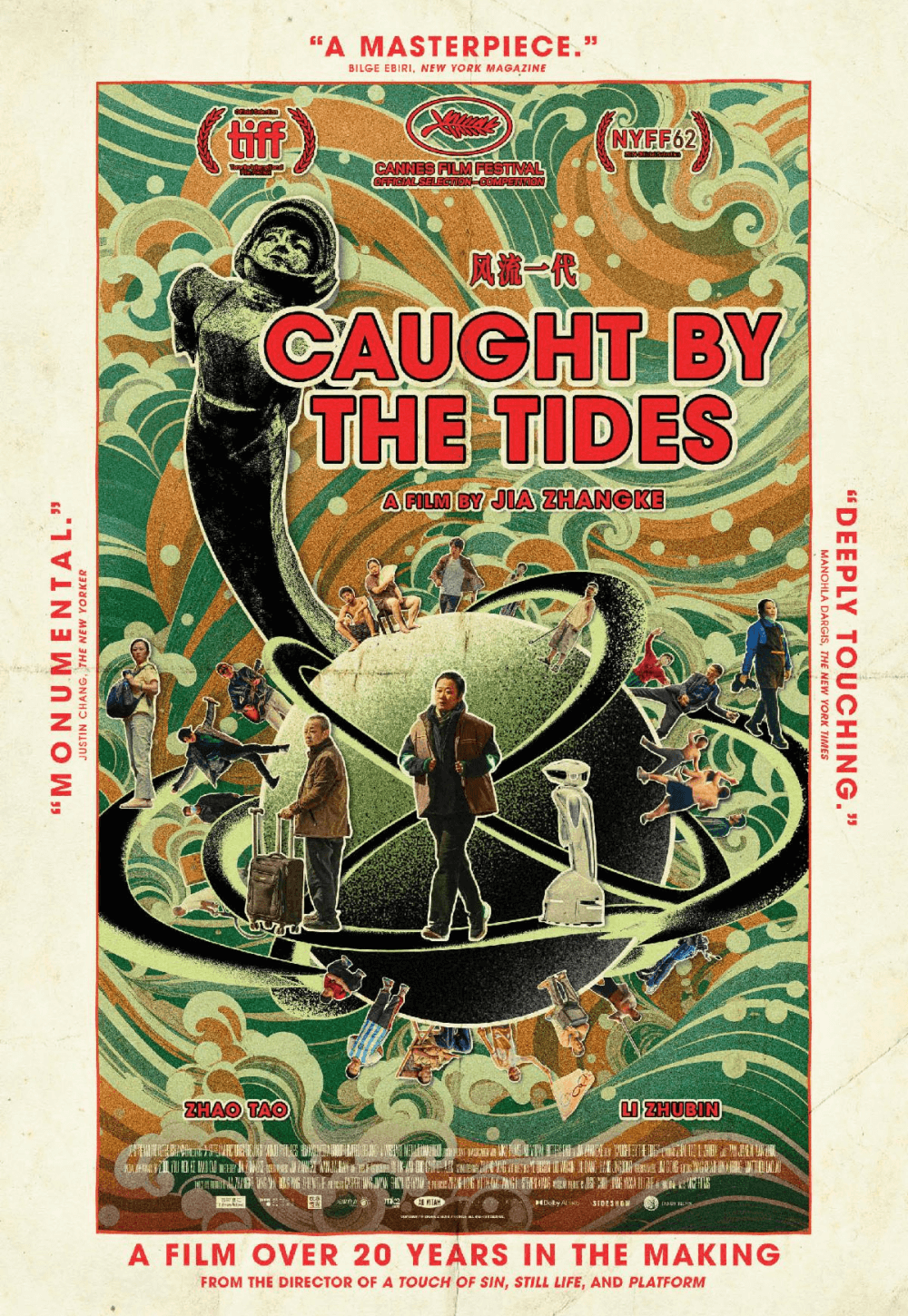Reader's Choice

Caught by the Tides
By Brian Eggert |
Note: Janus Films and Sideshow will release Caught by the Tides in theaters on May 9, 2025. This film was screened at the Minneapolis St. Paul International Film Festival and originally reviewed on Patreon on April 15, 2025.
A document of the historical and thematic undercurrents in the last 20 years of Jia Zhangke’s cinema, Caught by the Tides, the latest from the Sixth Generation Chinese director, plays like a medley or greatest hits album of scenes and ideas from his previous work. Jia has spent his entire career chronicling the sociopolitical and infrastructural changes resulting from China’s race to globalize, expand its economy, and urbanize its landscape, and how those dramatic updates have impacted his characters. He has approached this preoccupation by blending fiction and documentary within a single film (see Xiao Wu, 1997). However, sometimes he dabbles in pure nonfiction (I Wish I Knew, 2010) and occasionally pure drama (Mountains May Depart, 2015). Caught by the Tides is among Jia’s most experimental and unconventional films. In terms of structure, the film transcends the standards established during the last three decades of Jia’s output, even while ruminating on the same basic themes.
On the surface, Caught by the Tides shares much in common with his previous two features, Mountains May Depar and Ash Is Purest White (2018). Both involve notions of corruption or organized crime in narratives spanning many years. Similarly, the characters in his latest film dabble in some unspecified shady enterprise while the story unfolds over two decades. Jia assembled Caught by the Tides during the COVID-19 pandemic, during which the director began revisiting old and unused footage from more than two decades of projects. Combining documentary footage he shot but never used, scenes from several of his films, and deleted scenes from others, Jia builds a narrative from 20 years of discarded and recycled footage, supplemented by new material to give the film shape. Jia’s handheld camerawork and cinematography by Yu Lik-wai and Eric Gautier, along with their ever-shifting aspect ratios—reflective of creative choices made for the individual films from which the footage was sourced and the periods they shot them—give the new feature an unpredictable look and feel that reveal evidence of the production originating from several earlier projects.
Watched in a vacuum, without consideration of where the footage onscreen originated, the film opens in 2001 and follows Qiaoqiao, played by Jia’s wife and frequent star, the luminous Zhao Tao. Hailing from Datong, a city in Jia’s home in the Shanxi province, Qiaoqiao works as a promotional dancer and singer at a newly renovated venue. She soon enters a relationship with Brother Bin (Li Zhubin), a promoter who secures her work. Almost no screen time is devoted to their falling in love; Qiaoqiao doesn’t even speak unless she’s singing. Instead, their unhealthy relationship leads to a break. Bin resolves that he wants more than the modest opportunities available in Datong. He plans to leave town, promising to return when he has found something more lucrative. Years pass, and in 2006, Qiaoqiao begins searching around Fengjie for Bin, just upstream on the Yangtze River from the Three Gorges Dam. Even more time passes, and the two finally reconnect during the pandemic in 2021 but discover their dynamic has changed. Bin now needs Qiaoqiao. She has moved on.

Much of Caught by the Tides has been Frankensteined together from other movies. Early in their relationship, there’s a scene where Qiaoqiao attempts to depart on a bus, but Bin continues to push her back to comic-tragic effect; that moment consists of footage pulled directly from Jia’s Unknown Pleasures (2002). Some scenes of construction around Fengjie seem to come from Still Life (2006), while other shots of Qiaoqiao on a boat or wandering around and committing petty crimes hail from Ash Is Purest White—Zhao starred in both and wears an almost identical yellow shirt in each film. Some scenes are taken directly from these films; others have been repurposed from deleted scenes. Most of the new footage was taken during the pandemic, with a few amusing asides, such as news broadcasts remarking about the US’s botched containment of COVID-19 and a TikTok interlude. An oddly fascinating sequence finds Qiaoqiao wandering a mall, only to encounter a robot who tries to cheer her up by quoting Mother Teresa and Mark Twain.
Other peculiarities include a novel way of depicting speech and text-based communication. Jia deploys silent-film-style intertitles to show what Qiaoqiao has typed or even spoken. This places the emphasis on visuality over dialogue throughout Caught by the Tides, suggesting the viewer should be more of an observer than a listener of narrative information. Even so, the film features Jia’s most playful soundtrack. Music has always played a significant role in his films, from the live performances in Platform (2002) and Unknown Pleasures to the use of popular music, such as the Pet Shop Boys’ “Go West” in Mountains May Depart and the Village People’s “YMCA” in Ash Is Purest White. Lim Giong’s score adds a melancholy layer to connect the chapters in the film. At the same time, the changes in music from Asian pop songs to Western imports always have a nostalgic bent, underscoring the film’s interest in change over time.
From a certain perspective, the more familiar the viewer is with Jia’s filmography, the more rewarding the experience will be. There’s a pleasurable name-that-movie quality about identifying precisely how and from where Jia assembled his picture from pieces and leftovers from other projects. Then again, that awareness may have a distancing effect since the viewer recognizes how the narrative is an illusion created by editing material from otherwise unconnected films. But aren’t all movies assembled from pieces to create the impression of a story? To be sure, watching Caught by the Tides supplies an appreciation of how cinema remains an organized collage, cut together in such a way as to evoke an intended or interpreted response. However, just as an unfamiliar viewer may look at the film in confusion, given the scant story and character details, they may also feel more engaged by the story alone since they’re probably oblivious to the extratextual factors of its construction.
Besides the pandemic, Jia has been busy lately serving a five-year appointment as deputy in China’s legislative branch on the National People’s Congress. Having started his career making films that government censors banned from playing in mainland China, to becoming a deputy on a powerful government committee, seems like an unlikely trajectory. Yet, Jia continues to surprise those charting his career. Caught by the Tides is no exception and feels like a reset from his recent commercial-friendly projects into a more reflective and ponderous mode of filmmaking, albeit experimental and open to interpretation like his earliest or most underseen work. And though some of the footage may be repeated from elsewhere, the thoughtful edit (compiled by several editors overseen by Jia) manages to pull the viewer through time, absorbed in the physical changes of the landscape and actors. Like many of Jia’s films, Caught by the Tides has a mesmeric quality from its observational lens and expressive poignancy that remains enduringly fascinating.

If You Value Independent Film Criticism, Support It
Quality written film criticism is becoming increasingly rare. If the writing here has enriched your experience with movies, consider giving back through Patreon. Your support makes future reviews and essays possible, while providing you with exclusive access to original work and a dedicated community of readers. Consider making a one-time donation, joining Patreon, or showing your support in other ways.
Thanks for reading!
Brian Eggert | Critic, Founder
Deep Focus Review







